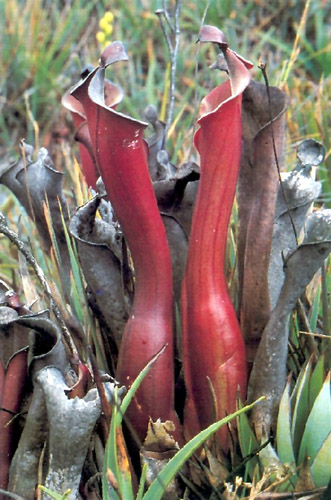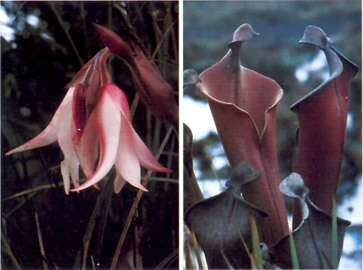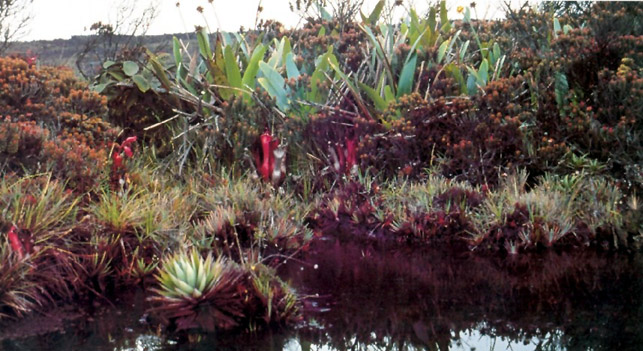|
Carnivorous Plant Newsletter
Volume 33, Number 4,
December 2004, pages 111 - 116; Front Cover
HELIAMPHORA ELONGATA (SARRACENIACEAE ),
A NEW SPECIES FROM ILU-TEPUI
JOACHIM NERZ • Boblingen • Germany
Keywords: new taxa: Heliamphora elongata, Venezuela.
Received: 30 December 2003
Introduction
Even today, Ilu-tepui remains very poorly explored due to its difficult access. The only way to reach its top is by helicopter. During two expeditions to Ilu-tepui I studied a new species of Heliamphora with characteristic elongated pitchers. The first expedition was made in October 1999 to the northeast part of Ilu-tepui (the expedition team consisted of Nerz, Hinderhofer & Carow). the second one was made in March 2004 to the south part of Ilu-tepui (the expedition team consisted of Nerz, Zimmermann & Hoogenstrijd). The mentioned species was photographed and illustrated as an unidentified species for the first time by Charles Brewer-Carias in 1977 (Brewer-Carias, 1987). On an expedition reported by Bill Baumgartl (1993), this species was observed, but identified incorrectly as Heliamphora ionasii because at that time, Heliamphora ionasii was the only described species from Ilu-tepui. In this paper, I describe this new species, and name it Heliamphora elongata. Also occurring on Ilu-tepui is the well known species Heliamphora ionasii, and in Table 1 I describe the differences between these two species and also with Heliamphora nutans (which seems to be the species most closely related to Heliamphora elongata).
While I have only observed Heliamphora elongata on Ilu-tepui, it has also been detected at the top of Tramen-tepui nearby (Geri Hoogenstrijd, pers. comm.). This species is a good example of speciation that occurs on the isolated sandstone-plateaus of the Guyana highlands. The tepui plateaus are highly isolated from each other. Steep cliffs and different climatic conditions between the plateaus and the surrounding area make it very difficult or impossible for plant species to spread from one tepui to another (George, 1988). Over time, each tepui has developed a high degree of endemic species. Even on closely situated tepuis, different species can be found. Such is the case with the restricted range of Heliamphora elongata.
Heliamphora elongata Nerz spec. nov.
Caudex ramosus, foliis caulescentibus vel rosulatis; amphoris 20-32 cm longis, infra medio anguste ventricosis, supra anguste tabulatis, orficiis infundiboliformibus; parallele plurinervibus et transversim reticulato-venosis, extus glabris, parte superiore interiore dense ciliatis intus dense strigosis pilis albis reflexis; appendice apicali cucullata, suborbiculari, 1-1.5 cm longa, 1-1.3 cm lato, basi constricta; inflorescentiis 2-5 - floris, racemosis, ad 50 cm longis; flores nutantes, pedicellis 1.5-3.5 cm longis, petalis 4 oblongo-lanceolatis, albidis rel rutilis, 3-5 cm longis; staminibus 11-19, 1-serialibus, filamentiis 5 mm longis; ovario valde tomentoso; stylo glabro; stigmata 3 lobato; seminibus fuscis, oblongis, ca. 3 mm longis, testa conspicue memrbranaceo-alata.
Herbaceous perennial; rhizomes branching, plants forming dense clumps. Pitchers narrowly ventricose in the lower half, narrowly cylindrical in the upper half, 20-32 cm long, infundibulate in the upper part, mouth 3.5-4 cm wide, ovate. External surface of the pitcher glabrous, inner surface in the upper half with tiny white hairs, in the lower half glabrous, at the base with some coarse hairs; older pitchers dark red, younger pitchers shiny red, rarely green. Lid helmet-shaped, on an elongated neck, 1-3 cm wide, 1.0-2.8 cm long, dark red to almost black. Inflorescence up to 50 cm long, 2-5 flowers, peduncle glabrous, pedicels 1.5-3.5 cm long, bracts ovate with a filiform appendix, bearing rudimentary pitchers, 3-4 cm long, at the upper flowers only 1 cm long. Tepals 4, narrowly oblong-lanceolate, 3-5 cm long, 1.5-1.8 cm wide, white to reddish. Stamens 11-19 in one series, filaments 5 mm long, anthers oblong-lanceolate, approximately 3 mm long, 1 mm wide; ovary 3-celled, 2 cm long, pubescent, style glabrous, seed approximately 3 mm long, compressed, ovate, irregularly winged.

Figure 1: Cluster of Heliamphora elongata pitchers.

Figure 2: Flowers of Heliamphora elongata. Figure 3: Two Heliamphora elongata pitchers.

Figure 4: Colony of Heliamphora elongata at Ilu-tepui.
Specimens Examined
Heliamphora elongata: Ilu-tepui S. 09.10.2004 Nerz No. HIlu/04/l, flowering plant (Ven)(Holotype)
Heliamphora elongata: Ilu-tepui S. 09.10.2004 Nerz No. HIlu/04/2, flowering plant (NY)(Isotype)
Heliamphora elongata: Ilu-tepui S. 09.10.2004 Nerz No. HIlu/04/3, sterile plant (Ven)
Heliamphora elongata: Ilu-tepui, Feb. 1977 F. Delaseio & Ch. Brewer No. 4967, flowering plant (Ven)
Heliamphora elongata: Ilu-tepui, 15.04.1988 Ronald Liesner No. 23356, sterile plant (Ven)
Heliamphora elongata: Ilu-tepui, 15.04.1988 Ronald Liesner No. 23381, flowering plant (Ven)
Heliamphora elongata: Ilu-tepui N, 09.10.1999 Nerz No. HIlu/99/1, pitcher and flower (Ven)
Heliamphora elongata: Ilu-tepui N, 09.10.1999 Nerz No. HIlu/99/2, pitcher and flower (NY)
Heliamphora elongata: Ilu-tepui N, 09.10.1999 Nerz No. HIlu/99/3, large pitcher (Ven)
Heliamphora elongata: Ilu-tepui N, 09.10.1999 Nerz No. HIlu/99/4, flowers, seed capsule and seed (Ven)
Distribution and Ecology
Heliamphora elongata is only known from Ilu-tepui and the nearby Tramen-tepui (Hoogenstrijd, pers. comm.). It is a common species there, and grows in small bogs.
The plateau of Ilu-tepui is at an altitude of approximately 2600 m; the surface usually consists of bare rock, and in the southern part there are many fissures. The vegetation there is very sparse because the heavy rains wash most of the substrate off the plateau, and because the climate is very cool, misty, and rainy. Heliamphora elongata survives in these difficult conditions by growing usually in small depressions where substrate can accumulate. Other plants that occur with it include typical tepui species from the genera Stegolepis, Xyris, Orectante, and Bonnetia. Carnivorous plants such as Drosera roraimae, Genlisea roraimensis, Utricularia quelchii, and Utricularia amethystina are also common, due to the restricted nutrient availability in the soil.
Heliamphora elongata grows very slowly, and only the most recently-formed 2-3 pitchers of each growing tip are alive; these are surrounded by many (usually 5-7) dead, persistent pitchers. This is the case even when the plants grow in large colonies. It seems that the soils are so nutrient-poor that the plants cannot maintain more than two or three pitchers alive at the same time. The old and dying pitchers may protect the living parts of the plant from mechanical damage from wind and rain. The bold red coloration of the pitchers protect it from the intense UV-radiation at these exposed, high elevation habitats. Although the conditions are very wet at the tops of the tepuis, the weather changes quickly, and it can quickly become dry and the intense sunlight can result in desiccation. The elongated pitchers, with a small opening at the top, would be very effective at retaining water with minimal evaporation. It is remarkable that so few insects were found in the pitchers, however insects are quite rare at the tops of tepuis.
Relationship to Other Species
Ilu-tepui is part of a group of tepuis in the southeast part of the Gran Sabana. One of these tepuis is the famous Roraima-tepui, and is where Heliamphora nutans (Bentham, 1840) can be found. This species is the closest relative of Heliamphora elongata. Due to the isolation of these tepuis, a clearly separated species with specific characteristics developed on Ilu- and Traman-tepui. The most obvious characteristics of Heliamphora elongata are the vertically elongated pitchers, the size of the pitchers, and the large, black lids. Heliamphora ionasii also occurs on Ilu-tepui, and can bear very large pitchers (Maguire, 1978). Heliamphora ionasii is clearly different from Heliamphora elongata (see Table 1). Bassett Maguire described it in 1978, and a spectacular photo of this species was published by Mazrimas (1979).
Heliamphora elongata has caused much confusion for those attempting to identify it. In herbarium collections (Delascio & Brewer, 1977, No. 4967 (Ven); Liesner, 1988, No. 23356 (Ven); 1988. No. 23381 (Ven) and in the literature (Baumgartl, 1993) specimens have been incorrectly determined as Heliamphora heterodoxa var. heterodoxa, H. cf. minor, H. nutans, or H. ionasii. The differences between Heliamphora nutans and H. ionasii are given in Table 1. Heliamphora minor has very short pitchers. Heliamphora heterodoxa var. heterodoxa can no longer be excusably confused with Heliamphora elongata because the pitcher and flower characteristics are quite different.
Table 1: Comparison between H. elongata, H. nutans and H. ionasii.
|
H. elongata |
H. nutans |
H. ionasii |
Pitcher |
|
|
|
Dimensions |
20-32 cm long
3-3.5 cm wide |
8-18 cm long
2-6 cm wide |
15-50 cm long
5-15 cm wide |
Shape |
Narrowly ventricose in
the lower part. narrowly
cylindrical in the upper
half, growing vertical
from the ground |
Ventricose in the lower
part, infundibuliform in
the upper part, at the
base bent to the middle |
Ventricose in the lower
part, highly expanded in
the upper part, at the
base bent to the middle |
Lid |
|
|
|
Dimensions |
1-3 cm long
1-2.8 cm wide |
0.5-1 cm long
0.5-1 cm wide |
0.8-1.8 cm long
1-2.5 cm wide |
Shape |
Helmet-shaped, bent
nearly horizontal over
the lid |
Cordate to helmet-
shaped, nearly vertical |
Cordate, curved |
Inflorescence |
|
|
|
Dimensions |
Peduncle 30-50 cm long
Pedicels 1.5-3.5 cm long |
Peduncle 25-60 cm long
Pedicels 2-4 cm long |
Peduncle -100 cm long
Pedicels 5-12 cm long |
Number of flowers
per scape |
2-5 |
2-5 |
2-10 |
Tepals |
|
|
|
Dimensions |
3-5 cm long
1.5-1.8 cm wide |
3-5 cm long
1-1.2 cm wide |
3.5-6 cm long
2.5-3 cm wide |
Shape |
Narrowly oblong-
lanceolate |
Lanceolate, broad base |
Lanceolate, broad base |
Anthers/ Stamens |
Dimensions |
3 mm long |
2.5 mm long |
3.5 mm long |
Number |
11-19 |
19-24 |
15-20 |
Hybrids
At a highland meadow close to Ilu-tepui, we observed (during the 2004 expedition) a population of Heliamphora ionasii and also specimens with characteristics intermediate between Heliamphora elongata and Heliamphora ionasii. It is likely that these specimens represent hybrids between these two species because Heliamphora elongata occurs relatively nearby.
Etymology
The species name "elongata" (elongated) was chosen due to the elongated pitchers, which are quite unusual for species of Heliamphora of the eastern tepuis.
Discussion
The Guyana Highlands region is a hotspot for evolution (George, 1988; Steyermark, et al., 1995). Due to the local and climatic isolation of the tepuis, an enormous degree of endemic species have developed over millions of years. In many species, it is obvious that they derive from the same ancestor. The populations of Heliamphora minor are in such a process of differentiation. The populations of this species on Auyan-tepui bear very fine, white hairs on the inner surface of the pitchers; meanwhile, the populations on the nearby Chimanta-tepui and Aprada-tepui have very coarse hairs at the inner surface of their pitchers. Also, other details such as the nature of the seedling pitchers are consistently different in these distinct populations. Another example of species differentiation in the genus Heliamphora can be observed in Heliamphora heterodoxa from the area of Ptari-tepui vs. Heliamphora folliculata from the Tres Testigos-group (Wistuba. et al., 2001). While the distance between Ptari-tepui and the Tres Testigos is less than 50 km, they are separated by vast savannahs, so in both areas evolution proceeded independently. Heliamphora heterodoxa and Heliamphora folliculata are obviously related (especially when we are comparing the specimens from the top of these tepuis), but they have clearly differentiated to become distinct species. At the Roraima-group of tepuis, the speciation of Heliamphora is similar. Each tepui is isolated by deep valleys that are covered with dense forest or savannahs which make it nearly impossible for Heliamphora species to migrate from one tepui to another. Three different species are now known to have developed at the Roraima-group of tepuis: Heliamphora nutans, known from Roraima-tepui, Kukenan-tepui and Yuruani-tepui; Heliamphora ionasii, known mainly from the northern slopes of Ilu-tepui: and Heliamphora elongata, currently only known from Ilu-tepui and Tramen-tepui. At the foothills of Tramen-tepui exist another dubious Heliamphora population, which seems to be closely related or identical with Heliamphora nutans.
Several years ago, botanists had the opinion that there existed two "groups" of Heliamphora species. In the western part of the range, where the tepuis are more tropical, only species with elon gated pitchers could be found, such as Heliamphora tatei and Heliamphora tatei var. neblinae. These species are adapted to the taller vegetation in this area (Gleason, 1931; Maguire, 1978). In the eastern range of tepuis, species with relatively short pitchers were found, that are adapted to more open habitats. These species include Heliamphora minor, Heliamphora nutans, Heliamphora heterodoxa, and Heliamphora ionasii. In recent years, new species of Heliamphora have been discovered (Nerz & Wistuba, 2000), which show that there is no strict borderline between Heliamphora species from the western tepuis and eastern tepuis. First, a Heliamphora species with very short pitchers was found on a western tepui (Cerro Neblina): Heliamphora hispida. This shows that species with short pitchers are able to grow on tepuis with relatively tall vegetation. Second, a species with elongated pitchers has now been discovered among the eastern tepuis: Heliamphora elongata. It is interesting that Heliamphora elongata grows in quite low vegetation. Another new eastern species with relatively long pitchers is Heliamphora chimantensis; this species grows in wet highland-meadows on Chimanta-tepui (Wistuba et al., 2002).
Literature
Baumgartl, W. 1993. The Genus Heliamphora. Carniv. Pl. Newslett. 22: 86-90.
Bentham, G. 1840. Heliamphora nutans, a new pitcher plant from British Guyana, Transactions of the Linnean Society. 18: 429-433.
Brewer-Carias, C. 1987. The lost world of Venezuela and its vegetation. Caracas, Venezuela.
Gleason, H.A. 1931. Botanical Results of the Tyler-Duida expedition. Bull. of the Torry Club. 58: 277-506.
George, U. 1988. Inseln in der Zeit. GEO im Verlag Gruner & Jahr AG.
Insectivorous Plant Society of Japan. 2003. Carnivorous Plants of the World: Amazing World of the Carnivorous Plants, p 131.
Maguire, B. 1978. Sarraceniaceae (Heliamphora) in The Botany of the Guyana Highland Part-X. Mem. of the New York Bot. Garden 29: 36-61.
Mazrimas, J.A. 1979. Recent status of Heliamphora. Carniv. Pl. Newslett. 8: 73, 82-85.
Nerz, J. and Wistuba, A. 2000. Heliamphora hispida (Sarraceniaceae), a New Species from Cerro Neblina, Brazil-Venezuela. Carniv. Pl. Newslett. 29: 37-41.
Steyermark , J.A., Berry, P.E., and Holst, B.K. 1995. Flora of the Venezuelan Guyana Vol. 1, Missouri, USA.
Wistuba, A., Harbarth, P., and Carow, T. 2001. Heliamphora folliculata, a new species of Heliamphora (Sarraceniaceae) from the 'Los Testigos' Table Mountains in the South of Venezuela. Carniv. Pl. Newslett. 30: 120-125.
Wistuba, A., Carow, T., and Harbarth, P. 2002. Heliamphora chimantensis, a new species of Heliamphora (Sarraceniaceae) from the 'Macizo de Chimanta' in the South of Venezuela. Carniv. Pl. Newslett 31: 78-82.

Front Cover: Heliamphora elongata in habitat on the northern plateau of Ilu-tepui. Photograph by Joachim Nerz.
|

